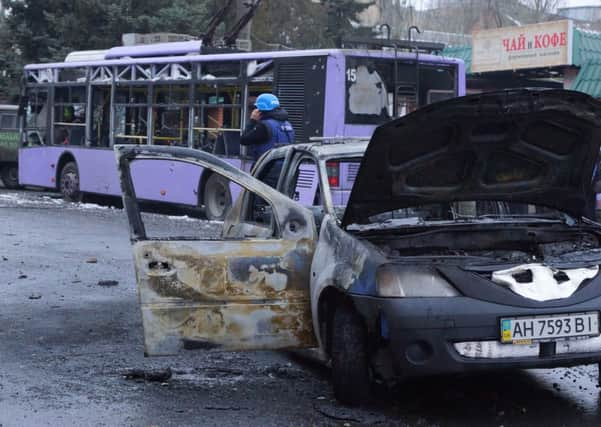Ukraine surrenders airport as bus attack kills 13


The withdrawal comes after a marked escalation in the conflict in recent days that has reportedly left dozens of Ukrainian troops dead and many more wounded.
It also came in the bloody wake of an artillery strike on a trolleybus in the centre of Donetsk that killed 13 civilians and left 20 wounded in one of the bloodiest single incidents of a war that has now claimed more than 5,000 lives.
Advertisement
Hide AdAdvertisement
Hide AdThe loss of the terminal building is a bitter blow to Ukraine, which had lauded its defenders as heroes fighting against the massed ranks of a foreign invader. Some in the Ukrainian press had even compared their stand to the Red Army’s defence of Stalingrad in the Second World War.
Yuriy Biryukov, a security advisor to the Ukrainian president, said yesterday: “We were unable to keep the ruins of the new terminal under our control in the past six days. The breaking point came the day before yesterday.”
The number of Ukrainian soldiers who died in the battle remained unclear last night. Ukraine’s defence ministry said the army had lost ten men to recent fighting but unofficial sources put the total at far higher.
“Today 37 heroes were killed at the airport,” Vladimir Sergeyev, a volunteer who helps provide equipment and supplies to the Ukrainian army, wrote on Facebook. “Many of them were finished off by Chechen scumbags. Forgive us, brothers! We did our best! Heroes do not die!”
The number of casualties on the rebel side remains unknown.
The fighting came despite a ceasefire agreement remaining in place, and the intensity of the violence appears to suggest the truce is now nothing more than a scrap of paper.
As an indication of the deteriorating situation in eastern Ukraine, pro-Moscow rebels paraded 20 Ukrainian prisoners of war through the streets of Donetsk to the site of the attack on the trolleybus.
Locals subjected the prisoners to verbal and physical abuse as they were marched to the site.
An official for the self-proclaimed Donetsk People’s Republic said the shelling “provides further evidence of the barbaric crimes being committed by the Kiev leadership” and called for an investigation by the United Nations and the Organisation for Security and Co-operation in Europe.
Advertisement
Hide AdAdvertisement
Hide AdSergei Lavrov, the Russian foreign minister, said Kiev and its “foreign sponsors” were responsible for this “monstrous new crime”.
But the Ukrainian government has denied responsibility. Arseniy Yatsenyuk, the Ukrainian prime minister, described the shelling as a “horrible act against humanity” and pointed the finger of blame at Moscow.
Ukraine has insisted the Kremlin is fuelling the conflict by providing political and material support to rebels, and by also contributing regular Russian troops to the battlefield. Moscow has continually denied these allegations, and claimed Kiev has produced no hard evidence to support its accusations.
In an effort to halt the fighting yesterday Germany, Russia, Ukraine and France issued a joint call for a cessation of hostilities and drew up a demarcation line behind which the opposing forces would withdraw, but the call appears to have made little or no impression.
Disturbed by the fighting, John Kerry, the US secretary of state, accused the rebels of a “blatant land grab” that contravened the ceasefire agreement while his colleague Samantha Power, Washington’s ambassador to the UN, said a recent peace proposal by Russian president Vladimir Putin was actually a “Russian occupation plan”.